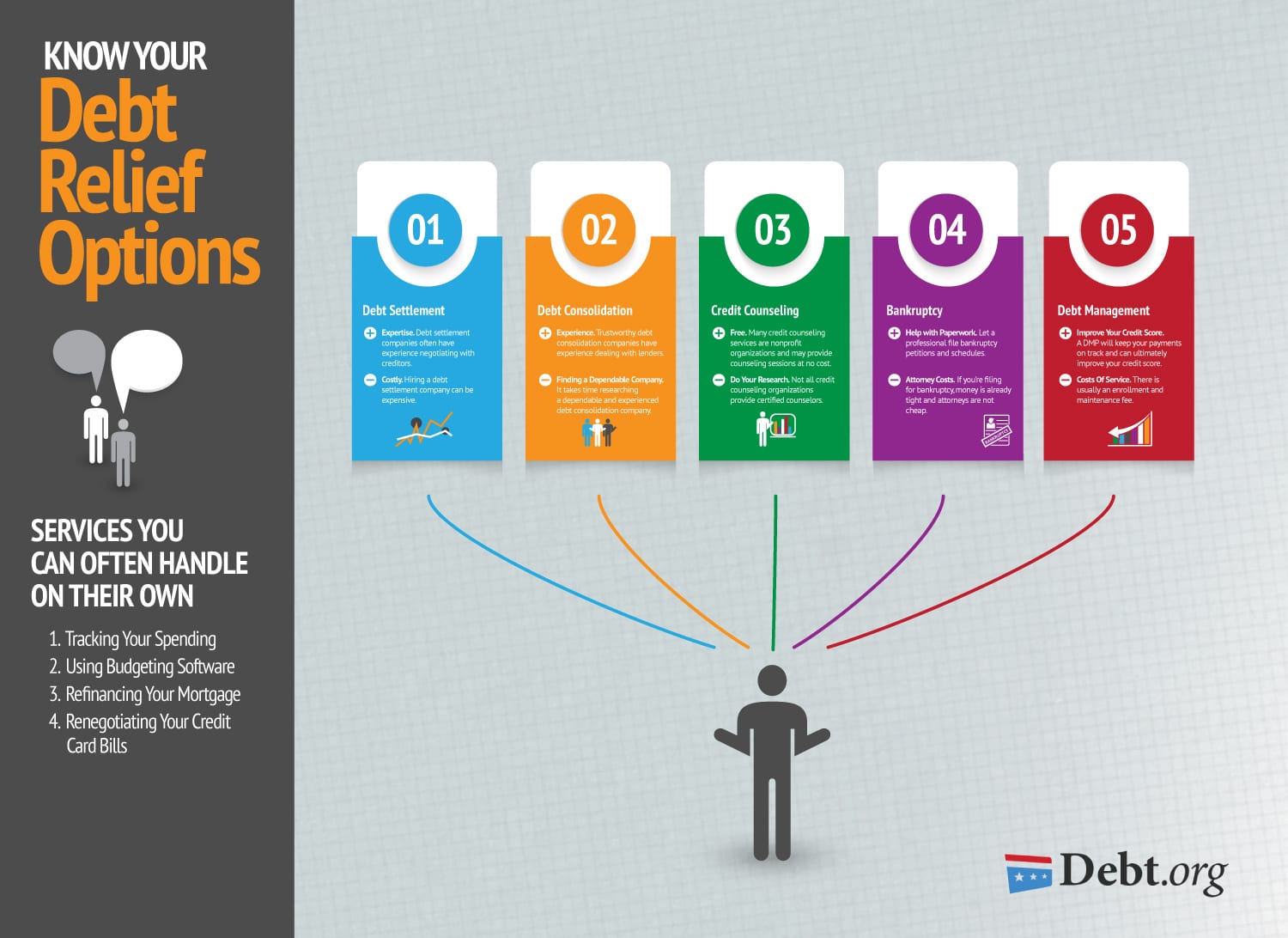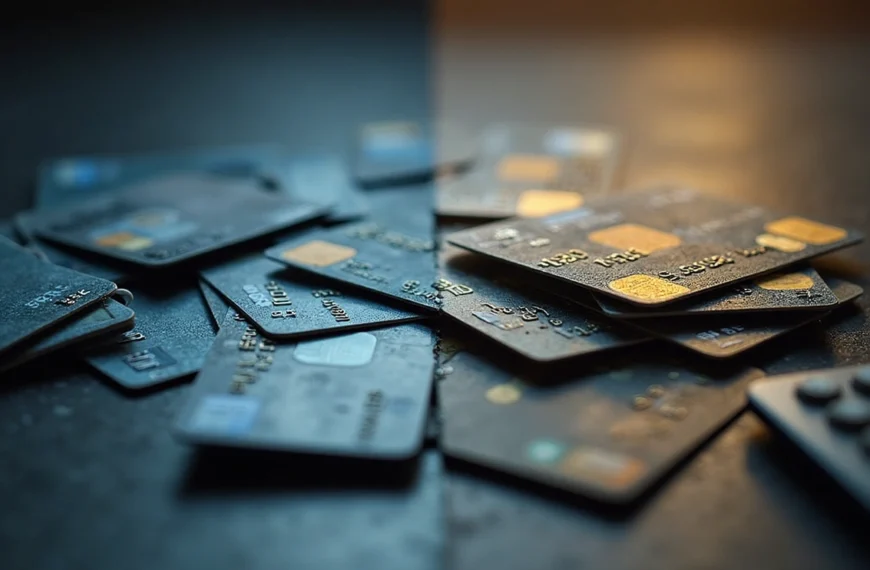American credit card debt has hit $1.21 trillion. This makes finding the best debt relief companies more significant than ever. Credit card interest rates now hover near 22%, and more people fall behind on payments each month. Many Americans now feel stuck in a cycle of never-ending debt.
Let’s get into the most trusted debt relief companies that have proven they can deliver results. Freedom Debt Relief stands out with over $19 billion in resolved debts since 2002. Accredited Debt Relief has helped their clients clear more than $1 billion since 2011. These top debt relief companies give people with at least $7,500 in unsecured debt a real alternative to bankruptcy. The fees range from 15% to 25% of enrolled debt. Programs from Debt Savers USA and other services need time to work – most settlements take 24 to 48 months to wrap up.
Why Debt Relief Is More Relevant Than Ever in Summer 2025

Image Source: Federal Reserve Bank of St. Louis
The economic climate of Summer 2025 brings new challenges for American consumers. Debt relief options have become a necessity rather than a choice for millions of households. Financial pressures come from all directions, and consumers now look to top debt relief companies to find ways out of overwhelming debt.
Rising interest rates and inflation
The Federal Reserve’s aggressive monetary policy has kept interest rates at historically high levels. Rates jumped from near-zero to over 5% in just two years, and consumers still feel the pinch even as inflation cools down. The average credit card interest rate has reached a record-breaking 22.80% for cards that accrue interest. A person with a $20,000 credit card balance at this rate would pay about $13,690 in interest over five years. This harsh reality drives many people to seek help from highest rated debt relief companies.
Record-high credit card debt
Credit card balances in America have hit an all-time high of $1.21 trillion. This adds to the new record household debt of $18.04 trillion. Credit card balances have shot up 51% since early 2021. Almost half (48%) of American cardholders carry balances from month to month. About 30% think it will take at least a year to clear their debt. Interest in best debt relief companies has grown substantially as people search for well-laid-out solutions to escape this cycle.
Limited access to traditional credit
Credit gets harder to find as financial strain grows. Credit card delinquency rates have reached their highest point since 2011, with about 7.2% of balances becoming delinquent. Banks have responded by making their lending rules stricter. Many consumers face tough times:
32% of Americans have maxed out their credit cards
37% use credit cards just to cover basic needs
All but one of these Americans cannot handle a $1,000 emergency expense
Services like Debt Savers USA and other debt relief programs have become vital lifelines for people drowning in debt. Traditional credit has become more expensive and harder to get. Debt relief companies now provide structured paths to financial recovery that weren’t needed before.
Expert-Verified List of the Best Debt Relief Companies
We’ve put together a list of top debt relief companies that have shown great results in helping people get out of debt. Our team looked at their success rates, how clear they are about fees, and what customers say about them.
1. National Debt Relief
National Debt Relief has some of the lowest fees in the business – 15% to 25% of settled debt. They need at least $10,000 in debt and have helped more than 400,000 clients so far. The company handles credit cards, personal loans, medical bills, and even private student loans. Their services aren’t available in Connecticut, Oregon, Vermont, and West Virginia.
2. Freedom Debt Relief
This 21-year old company has helped over one million customers clear more than $20 billion in debt. Most people finish their program in 24-48 months, with fees between 15% and 25%. They stand out with a “program guarantee” that puts a cap on your fees if settlement costs go above your enrolled debt.
3. Accredited Debt Relief
Customer service is where Accredited Debt Relief shines. They’re available on weekdays from 8 a.m. to 11 p.m. EST and have weekend hours too. Customers love them – they’ve got 4.8 stars on Trustpilot and 4.89 on BBB. They charge 25% for settled debts and need at least $10,000 in unsecured debt.
4. New Era Debt Solutions
New Era Debt Solutions has been around since 1999 and charges 14% to 23% of enrolled debt – some of the lowest rates out there. Their clients usually get debt-free in 27.73 months. The company works everywhere except Iowa, Maine, and Oregon, following some legal issues with Oregon in 2021.
5. Pacific Debt Relief
Pacific Debt Relief keeps their fees competitive at 15% to 25% on settled debt and gets great reviews (4.7 stars on Trustpilot). Since 2002, they’ve cleared over $500 million in consumer debt. They work everywhere except Oregon and help clients become debt-free in 24 to 48 months with customized plans.
6. CuraDebt
CuraDebt stands out as the only company here that helps with tax debt relief. They’ve been around for 23 years and won’t charge you until they settle your debts. Free consultations are available.
7. Americor
Americor works with debts starting at $7,500 and charges between 14% and 29% of enrolled debt. They operate everywhere except Colorado, Oregon and West Virginia. Their Trustpilot rating is 4.9/5 from over 12,000 reviews. Their clients typically save about 45% of their enrolled debt.
8. CreditAssociates
CreditAssociates has spent 15 years helping people reduce their debt by up to 50% in 24-36 months. They’ve earned an A+ BBB accreditation and a solid 4.9/5 Trustpilot rating. Almost all their reviewers (98% of 19,000+) give them four or five stars. They back their service with a strong money-back guarantee.
How These Companies Actually Help You Save

Image Source: Debt.org
People struggling with overwhelming debt need financial relief as a priority. Top debt relief companies help clients save money through proven strategies. These methods show why professional debt relief services are worth thinking about.
Negotiating lower balances
Debt settlement is the life-blood of how highest rated debt relief companies deliver savings. These organizations negotiate with creditors to accept less than the full balance owed—typically 30% to 50% below the original debt amount. Creditors prefer receiving partial payment rather than getting nothing if a customer files for bankruptcy. Clients stop making payments directly to creditors and build funds in a dedicated settlement account. The debt relief company negotiates lump-sum settlements with each creditor individually once sufficient funds accumulate.
Reducing interest and fees
Debt relief companies secure major savings through interest rate reductions beyond principal reduction. Credit counselors work directly with creditors to lower interest rates—often bringing them down to around 8% or even less. Many creditors agree to waive late fees and other penalties that compound debt problems. These savings add up over time, especially with the current average credit card interest rate of 22.8%.
Consolidating payments into one monthly plan
Debt relief programs make finances simpler by combining multiple debts into a single monthly payment. Fixed payment terms create predictability, typically ranging from 36 to 84 months. The well-laid-out nature of these programs prevents confusion and missed payments that lead to compounding financial problems. Clients receive regular updates on their progress, which makes budgeting easier.
Avoiding bankruptcy through structured plans
Best debt relief companies provide structured alternatives to bankruptcy, which matters most. Bankruptcy remains valid for some but carries long-term consequences for credit scores and financial opportunities. Credit counseling agencies’ debt management plans help consumers pay their debts in full—albeit with reduced interest—without bankruptcy’s severe credit impact. Debt settlement programs offer middle-ground options that resolve debts for less than full balance without court proceedings. These structured approaches resolve debt within 24-48 months, offering faster recovery than Chapter 13 bankruptcy plans that often extend to five years.
What to Know Before You Enroll in a Program
Image Source: Template.net
You must understand the fine print that comes with debt relief programs before making any commitments. Top debt relief companies have specific rules and methods that will affect your financial trip.
Minimum debt requirements
Most debt relief programs won’t accept clients unless they meet certain debt thresholds. National Debt Relief needs you to have at least $7,500 in unsecured debt to qualify. Other debt settlement companies set their limits between $3,000 to $10,000. Nonprofit credit counseling agencies work differently. Their debt management programs welcome clients with any amount of debt—even those who owe as little as $1,000. Make sure your type of debt qualifies because these programs usually only work with unsecured debts like credit cards, personal loans, and medical bills.
Impact on your credit score
Your credit score will take a big hit if you join a debt settlement program. Companies ask their clients to stop paying creditors during negotiations. This leads to negative reports going to credit bureaus. Your score could drop by about 100 points. Settled debts stay on your credit reports as “paid-settled” for seven years. Debt management plans might lower your scores slightly at first because accounts get closed. The good news is scores tend to get better after a year of regular payments.
How long the process takes
Different programs take different amounts of time. Debt settlement usually needs 24 to 48 months to finish. You’ll see your first settlements after six to nine months once you save enough money in your dedicated settlement account. Debt management plans usually run for 3 to 5 years. The time it takes depends on your savings rate, number of creditors, and total debt.
What fees you’ll pay and when
We charged performance-based fees between 15% to 25% of enrolled debt for debt settlement. You only pay these fees after successful settlements. Let’s say you settle $10,000 in debt for $5,000—you’d pay around $2,500 in fees (25% of original debt). On top of that, many programs charge monthly account fees ($5 to $20) and setup fees ($9 to $50). Nonprofit debt management programs cost less. They usually charge $25 to $75 each month plus setup fees between $30 and $50.
Conclusion
Finding Your Path to Financial Freedom
Debt relief programs give Americans a way out as they struggle with the $1.21 trillion credit card debt crisis. The economic world of 2025 has created new financial challenges. Professional debt relief services have become more crucial than ever.
Top debt relief companies share some vital features – clear fee structures, proven settlement history, and great customer ratings. Freedom Debt Relief and National Debt Relief showed their worth by helping resolve billions in consumer debt over decades. CuraDebt also offers special services that target specific debts, like tax obligations.
These programs use smart negotiations to cut principal balances by 30% to 50%. They can lower interest rates and unite multiple payments into one monthly plan. You need to think over several things before signing up. Most settlement programs need minimum debt between $7,500 and $10,000. The process takes 24 to 48 months and might temporarily affect your credit score.
Fees matter too. Debt relief companies take 15% to 25% of enrolled debt, but only after they settle it. You should work out both savings and costs before you commit.
Debt relief isn’t right for everyone. People with smaller debts might do better with debt management plans through nonprofit credit counseling. If you face huge debt with limited income, debt settlement could be the structured option you need instead of bankruptcy.
The path to financial freedom needs good research and honest self-assessment. Debt relief companies give you strong tools to resolve debt. Your success depends on picking the right program for your money situation and sticking with it. This information helps you assess your options and take solid steps toward lasting financial stability.
FAQs
Q1. What are the minimum debt requirements for most debt relief programs? Most debt relief companies require a minimum of $7,500 to $10,000 in unsecured debt to qualify for their programs. However, some nonprofit credit counseling agencies may accept clients with as little as $1,000 in debt.
Q2. How long does the debt relief process typically take? The debt relief process usually takes between 24 to 48 months to complete. This timeline can vary depending on factors such as the amount of debt, number of creditors, and how quickly you can save money for settlements.
Q3. What fees do debt relief companies charge? Debt relief companies typically charge performance-based fees ranging from 15% to 25% of the enrolled debt. These fees are only applied after successful settlements. Some programs may also have additional monthly maintenance fees and setup fees.
Q4. How does enrolling in a debt relief program affect credit scores? Enrolling in a debt settlement program can initially cause a significant drop in your credit score, potentially by around 100 points. This is because the program often requires you to stop making payments to creditors during negotiations. However, debt management plans may have a less severe impact on credit scores.
Q5. What types of debt can be included in debt relief programs? Most debt relief programs focus on unsecured debts such as credit card balances, personal loans, and medical bills. Some specialized programs may also handle other types of debt, such as private student loans or even tax obligations in certain cases.
References
[1] – https://www.cbsnews.com/news/how-long-does-credit-card-debt-relief-take/
[2] – https://www.investopedia.com/ask/answers/110614/how-will-debt-settlement-affect-my-credit-score.asp
[3] – https://abcnews.go.com/Business/americans-credit-card-debt-reaches-new-record-high/story?id=118788620
[4] – https://www.bankrate.com/credit-cards/news/credit-card-debt-report/
[5] – https://finance.yahoo.com/personal-finance/credit-cards/article/credit-card-debt-statistics-214220233.html
[6] – https://www.nationaldebtrelief.com/resources/debt-relief-settlement/top-faqs-debt-relief/
[7] – https://www.cbsnews.com/news/credit-card-debt-relief-strategies-to-consider-for-2025/
[8] – https://www.cnbc.com/select/what-are-debt-relief-companies/
[9] – https://www.incharge.org/debt-relief/debt-consolidation/free-debt-credit-consolidation/
[10] – https://consumer.ftc.gov/articles/how-get-out-debt
[11] – https://www.moneymanagement.org/debt-management/debt-management-plan-vs-bankruptcy
[12] – https://www.discover.com/personal-loans/debt-consolidation/
[13] – https://www.pnc.com/en/personal-banking/borrowing/personal-loans/unsecured-personal-loan/credit-card-consolidation-loans.html
[14] – https://www.nationaldebtrelief.com/resources/bankruptcy/
[15] – https://mccarthylawyer.com/2025/05/09/how-to-settle-debt-without-filing-for-bankruptcy-your-complete-guide/
[16] – https://www.nationaldebtrelief.com/blog/debt-guide/debt-relief/how-do-you-qualify-for-debt-relief/
[17] – https://www.cbsnews.com/news/how-to-qualify-for-debt-relief-in-2025/
[18] – https://www.incharge.org/debt-relief/debt-management/how-much-debt-do-i-need-for-your-program/
[19] – https://www.incharge.org/debt-relief/debt-settlement/effect-on-credit-report/
[20] – https://alleviatefinancial.com/debt-settlement/how-long-does-it-take-to-settle-credit-card-debt-understanding-the-timeline/
[21] – https://www.cbsnews.com/news/how-much-does-a-debt-relief-program-cost/
[22] – https://www.nerdwallet.com/article/loans/personal-loans/national-debt-relief-debt-settlement
[23] – https://www.debt.org/settlement/debt-settlement-fees/
[24] – https://alleviatefinancial.com/debt-settlement/how-much-does-debt-relief-cost/













![No Win No Fee Lawyers: The Hidden Truth About Settlement Cuts Legal representation through no win no fee lawyers gives clients a way to fight cases without paying anything upfront. Many clients don't know that these services take a big chunk of money after winning the case. Lawyers usually take 25% to 40% of what you win as their contingency fee. The amount lawyers take from settlements can add up fast. A $100,000 settlement means your attorney gets $30,000 if they charge a 30% fee after winning your case. Your solicitor's cut might be £10,000 from a £30,000 compensation award, based on your agreement percentage. This payment model stays pretty much the same for no win no fee lawyers in different places, though percentages can change. This piece breaks down what you need to know about contingency fee deals. You'll learn about standard fee ranges, extra costs beyond the basic fee, and times when this payment setup might not work in your favor. Smart clients should think over these money matters before signing up with a lawyer to make better choices about their legal help. What No-Win No-Fee Really Means Image Source: Express Legal Funding A no-win no-fee arrangement, also called a Conditional Fee Agreement, changes the way people get legal help. This payment approach removes the need to pay legal fees upfront and creates a partnership between clients and their attorneys. How contingency fees work No-win no-fee agreements are based on contingency fees. Lawyers get paid only when they win compensation for their clients. Most lawyers take between 25% and 40% of the final amount, based on how complex the case is and where it's filed. Lawyers take their cut after winning the case. To name just one example, see a case where a lawyer wins £30,000 in compensation with a 33% fee - they would receive £10,000. On top of that, some law firms use sliding scales where they charge less for quick settlements and more if the case goes to trial. The law requires a written agreement before any work starts. This paperwork spells out the lawyer's percentage, what costs you'll need to cover, and other key details. What happens if you lose the case The meaning behind "no-win no-fee" is clear - losing your case means you won't pay your lawyer anything. All the same, you should know about a few money-related details. You won't owe your lawyer when you lose, but some deals might make you pay for court fees, expert witnesses, or other case expenses. The other side could also ask you to pay their legal costs. Many lawyers suggest getting "After Event" insurance to protect their clients. These policies cover any costs if you lose your case, which makes the no-win no-fee setup much safer. Why lawyers offer this model Lawyers want to make legal help available to more people, so they offer these payment plans. This setup helps people who don't have much money take legal action when they have valid claims. The payment structure motivates lawyers to work hard. They only get paid by winning cases, which pushes them to get the best results possible. Lawyers carefully assess each case before taking it on a no-win no-fee basis. They usually accept cases that have a good chance of winning, since they put in lots of time and resources without any guaranteed payment. The Real Cost: How Much Do Lawyers Take from a Settlement Image Source: Greiner Law Corp. The true cost of no-win no-fee legal representation becomes clear once we look at contingency fees. Many clients feel surprised to see a big chunk of their settlement checks going to their attorney's fees. Typical percentage ranges (25%–40%) No win no fee lawyers typically ask for 25% to 40% of the total settlement amount. Personal injury attorneys usually take 33.3% (one-third) of the awarded compensation[101]. Lawyers and clients agree on this percentage before any work starts on the case. Several factors shape the final percentage. Your chances of winning, case complexity, and the work to be done play key roles in determining the attorney's cut. Some areas have laws that cap the maximum contingency fees for specific types of cases. Sliding scale based on case complexity Law firms often use a tiered fee system that changes with the case stage and complexity. This scale rewards quick settlements while paying attorneys fairly if more work becomes needed. The fee might start at 30% if the case settles before lawsuit filing. This number could climb to 35% after filing or reach 40% if the case goes to trial. Law firms often group cases by complexity: 10%-20%: Simple cases with straightforward settlements 25%-35%: Typical personal injury cases 35% and above: Complex cases requiring extensive resources Examples of payout breakdowns These ground examples show how fees affect settlements: A $15,000 settlement with a 33.3% contingency fee.pdf) puts $5,000 in the attorney's pocket, leaving $10,000 for the client. Similarly, from a $100,000 settlement with a 33% fee, the attorney gets $33,000 while the client receives $67,000[102]. Complex cases tell a different story. A $100,000 settlement with a 30% fee plus $5,000 in extra costs leaves $65,000 for the client after all deductions. These fees substantially change the client's final payout. Hidden Costs You Might Not Expect Image Source: Nelson Personal Injury Lawyers Beyond percentage-based fees, clients often feel surprised by extra costs that can reduce their final compensation by a lot. These hidden costs show up in the fine print of no-win no-fee agreements. You should think over these details before signing. Court filing and expert witness fees Legal proceedings come with unavoidable court filing fees. These charges differ by jurisdiction. They usually range from $30 for small claims to several hundred dollars for complex civil lawsuits. Expert witnesses can be expensive, with hourly rates ranging from $150 to $1,000 based on their credentials and testimony complexity. Expert witnesses charge more for court appearances than consultation work because of added pressure and prep time. Clients might still need to pay experts for their prep work even if the case settles before trial. Medical report and investigation costs Medical documentation is a vital part of many legal claims. These costs include fees to release medical records, create specialized reports, and prepare documents. Investigation costs cover evidence gathering, police reports, witness interviews, and other fact-finding work needed to build a strong case. Of course, some firms say they'll cover these expenses upfront, but clients don't completely avoid these costs. When these costs are deducted from your compensation Law firms take these expenses from the settlement amount before they calculate their percentage fee, though each firm handles this differently. Some lawyers subtract these costs after figuring out their contingency fee, which changes how much money clients end up with. Most firms pay case-related costs during the process and get their money back from the settlement. The defendant usually pays most simple legal costs and disbursements in successful cases, but not always everything. Insurance protects clients from costs in unsuccessful claims at many law firms, but this protection isn't guaranteed. Clients should review their agreements carefully since they might still need to pay specific expenses even if they lose their case. When No-Win No-Fee Might Not Be the Best Option Contingency fee arrangements give many people access to justice. However, this payment model doesn't always work in a client's best interests. Knowing these limitations helps clients make better decisions about their legal representation. Cases with unclear liability Lawyer no win no fee arrangements work best in cases where fault is clear. We assessed the probability of success before taking contingency cases. Lawyers might turn down cases if there isn't enough evidence of the other party's negligence or if liability isn't certain. Cases with multiple responsible parties create more challenges. The situation gets complicated fast when several parties share liability. Lawyers are less likely to take these cases on contingency. They need to be confident they can prove the other party's negligence before accepting a case. Low-damage or low-payout claims Small claims often don't work well with the contingency model, even with real injuries. Cases that have minimal injuries or limited financial damages might not bring enough compensation to cover legal costs. The potential settlement needs to be big enough to pay for investigations, witness interviews and court fees. Personal injury lawyers often turn down cases where the "compensation potential" is too small. This doesn't mean the claim isn't valid - it just means the economics don't add up for a contingency arrangement. Situations where hourly billing may be better Hourly billing has clear advantages in certain cases. Clients see exactly what they're paying for - every hour worked and task completed. This model works well for cases that need lots of attention but don't have clear financial outcomes. Complex litigation with opposing parties works better with hourly billing and a retainer fee. Clients have more control over their case and don't feel pressured to settle quickly. Cases that need extensive preparation but have uncertain outcomes fit the hourly model better. Lawyers can spend the time needed without worrying about contingency limits. This approach often leads to better representation, especially for complex legal issues that need special expertise. Conclusion Understanding the Full Picture Before You Sign No-win no-fee arrangements offer legal representation without upfront costs. Of course, this seems attractive at first glance. In spite of that, you need to think about how these agreements can affect your final compensation. Legal fees usually range from 25% to 40% of your settlement - but that's just the start. You'll face more deductions like court filing fees, expert witness costs, and charges for medical documentation. What looks like a "free" service ends up taking a big chunk of your compensation to cover legal expenses. These arrangements work best in specific situations - cases with obvious liability, substantial damages, and solid evidence. If you have a low-value claim or complex liability issues, traditional hourly billing might serve you better. Without doubt, you should ask for clear explanations of all possible costs before signing anything. Read the fine print closely, especially when you have to deal with expenses in unsuccessful cases. Ask to see sample settlement breakdowns that show all deductions. This helps you picture what you might actually take home. Your choice to go with a no-win no-fee arrangement depends on your situation. This model helps if you don't have money to pursue valid claims. But if you have a strong case and enough funds, other fee structures might let you keep more of your compensation. Whatever payment model you choose, knowing exactly how much lawyers take from settlements helps you make better decisions. This knowledge lets you approach legal representation with real expectations and better control over your money. FAQs Q1. What percentage of a settlement do no-win no-fee lawyers typically take? No-win no-fee lawyers typically charge between 25% to 40% of the final settlement amount as their contingency fee. The exact percentage often depends on the complexity of the case and the stage at which it is resolved. Q2. Are there any hidden costs in no-win no-fee arrangements? Yes, there can be additional costs beyond the lawyer's percentage fee. These may include court filing fees, expert witness costs, medical report expenses, and investigation costs. These expenses are usually deducted from the settlement amount before or after the lawyer's fee is calculated. Q3. What happens if I lose my case in a no-win no-fee arrangement? If you lose your case, you generally won't have to pay your lawyer's fees. However, you might still be responsible for certain expenses like court costs or the opposing party's legal fees. Many lawyers offer insurance to protect clients from these potential costs in case of an unsuccessful claim. Q4. When might a no-win no-fee arrangement not be the best option? No-win no-fee arrangements may not be ideal for cases with unclear liability, low-value claims, or complex legal issues requiring extensive preparation. In these situations, traditional hourly billing might be more appropriate and potentially more cost-effective for the client. Q5. Can I negotiate the percentage a lawyer takes from my settlement? Yes, the contingency fee percentage is often negotiable. It's typically agreed upon and formalized in writing before the lawyer begins working on your case. Don't hesitate to discuss the fee structure with your lawyer and ask for a detailed breakdown of potential costs and deductions.](https://consumersweek.com/wp-content/uploads/2025/06/No-Win-No-Fee-Lawyers-The-Hidden-Truth-About-Settlement-Cuts-870x570.webp)



